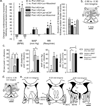Neural pathways underlying lactate-induced panic
- PMID: 18059441
- PMCID: PMC3065200
- DOI: 10.1038/sj.npp.1301621
Neural pathways underlying lactate-induced panic
Abstract
Panic disorder is a severe anxiety disorder characterized by susceptibility to induction of panic attacks by subthreshold interoceptive stimuli such as 0.5 M sodium lactate infusions. Although studied for four decades, the mechanism of lactate sensitivity in panic disorder has not been understood. The dorsomedial hypothalamus/perifornical region (DMH/PeF) coordinates rapid mobilization of behavioral, autonomic, respiratory and endocrine responses to stress, and rats with disrupted GABA inhibition in the DMH/PeF exhibit panic-like responses to lactate, similar to panic disorder patients. Utilizing a variety of anatomical and pharmacological methods, we provide evidence that lactate, via osmosensitive periventricular pathways, activates neurons in the compromised DMH/PeF, which relays this signal to forebrain limbic structures such as the bed nucleus of the stria terminalis to mediate anxiety responses, and specific brainstem sympathetic and parasympathetic pathways to mediate the respiratory and cardiovascular components of the panic-like response. Acutely restoring local GABAergic tone in the DMH/PeF blocked lactate-induced panic-like responses. Autonomic panic-like responses appear to be a result of DMH/PeF-mediated mobilization of sympathetic responses (verified with atenolol) and resetting of the parasympathetically mediated baroreflex. Based on our findings, DMH/PeF efferent targets such as the C1 adrenergic neurons, paraventricular hypothalamus, and the central amygdala are implicated in sympathetic mobilization; the nucleus of the solitary tract is implicated in baroreflex resetting; and the parabrachial nucleus is implicated in respiratory responses. These results elucidate neural circuits underlying lactate-induced panic-like responses and the involvement of both sympathetic and parasympathetic systems.
Figures





Similar articles
-
Panic-prone state induced in rats with GABA dysfunction in the dorsomedial hypothalamus is mediated by NMDA receptors.J Neurosci. 2006 Jun 28;26(26):7093-104. doi: 10.1523/JNEUROSCI.0408-06.2006. J Neurosci. 2006. PMID: 16807338 Free PMC article.
-
Disruption of GABAergic tone in the dorsomedial hypothalamus attenuates responses in a subset of serotonergic neurons in the dorsal raphe nucleus following lactate-induced panic.J Psychopharmacol. 2008 Aug;22(6):642-52. doi: 10.1177/0269881107082900. Epub 2008 Feb 28. J Psychopharmacol. 2008. PMID: 18308791 Free PMC article.
-
Orexin 1 receptors are a novel target to modulate panic responses and the panic brain network.Physiol Behav. 2012 Dec 5;107(5):733-42. doi: 10.1016/j.physbeh.2012.04.016. Epub 2012 Apr 24. Physiol Behav. 2012. PMID: 22554617 Free PMC article.
-
An animal model of panic vulnerability with chronic disinhibition of the dorsomedial/perifornical hypothalamus.Physiol Behav. 2012 Dec 5;107(5):686-98. doi: 10.1016/j.physbeh.2012.03.016. Epub 2012 Mar 26. Physiol Behav. 2012. PMID: 22484112 Free PMC article. Review.
-
Hypothalamic Regulation of Cardiorespiratory Functions: Insights into the Dorsomedial and Perifornical Pathways.Biology (Basel). 2024 Nov 15;13(11):933. doi: 10.3390/biology13110933. Biology (Basel). 2024. PMID: 39596888 Free PMC article. Review.
Cited by
-
Group II metabotropic glutamate receptor type 2 allosteric potentiators prevent sodium lactate-induced panic-like response in panic-vulnerable rats.J Psychopharmacol. 2013 Feb;27(2):152-61. doi: 10.1177/0269881112454230. Epub 2012 Aug 21. J Psychopharmacol. 2013. PMID: 22914798 Free PMC article.
-
Sex differences in anxiety and emotional behavior.Pflugers Arch. 2013 May;465(5):601-26. doi: 10.1007/s00424-013-1271-7. Epub 2013 Apr 16. Pflugers Arch. 2013. PMID: 23588380 Free PMC article. Review.
-
Evaluation of JNJ-54717793 a Novel Brain Penetrant Selective Orexin 1 Receptor Antagonist in Two Rat Models of Panic Attack Provocation.Front Pharmacol. 2017 Jun 9;8:357. doi: 10.3389/fphar.2017.00357. eCollection 2017. Front Pharmacol. 2017. PMID: 28649201 Free PMC article.
-
Stress-related serotonergic systems: implications for symptomatology of anxiety and affective disorders.Cell Mol Neurobiol. 2012 Jul;32(5):695-708. doi: 10.1007/s10571-012-9827-1. Epub 2012 Apr 7. Cell Mol Neurobiol. 2012. PMID: 22484834 Free PMC article. Review.
-
A hypothalamomedullary network for physiological responses to environmental stresses.Nat Rev Neurosci. 2022 Jan;23(1):35-52. doi: 10.1038/s41583-021-00532-x. Epub 2021 Nov 2. Nat Rev Neurosci. 2022. PMID: 34728833 Review.
References
-
- Abshire VM, Hankins KD, Roehr KE, DiMicco JA. Injection of L-allylglycine into the posterior hypothalamus in rats causes decreases in local GABA which correlate with increases in heart rate. Neuropharmacology. 1988;27:1171–1177. - PubMed
-
- Catelli JM, Sved AF. Enhanced pressor response to GABA in the nucleus tractus solitarii of the spontaneously hypertensive rat. Eur J Pharmacol. 1988;151:243–248. - PubMed
-
- Chen T, Hui R, Dong YX, Li YQ, Mizuno N. Endomorphin 1- and endomorphin 2-like immunoreactive neurons in the hypothalamus send axons to the parabrachial nucleus in the rat. Neurosci Lett. 2004;357:139–142. - PubMed
Publication types
MeSH terms
Substances
Grants and funding
LinkOut - more resources
Full Text Sources
Other Literature Sources
Medical

